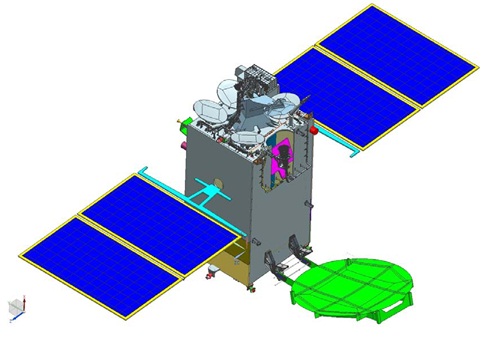The Indian Space Research Organisation (Isro) today launched the country's 35th communication satellite, the GSLV-7A, from its launch pad at Sriharikota on board geosynchronous launch vehicle GSLV-F11.
Around 19 minutes after the lift-off at 4:10 pm, the three-stage rocket ejected the satellite into a geosynchronous transfer orbit.
In the coming days, the satellite will be moved to its final geostationary orbital slot at an altitude of around 35,000 km by firing its onboard chemical propulsion system.
The 2,250-kg geostationary satellite GSAT-7A has been built to provide communication capability to the users in Ku-band over the Indian region and will give a boost to military communication, especially for the Indian Air Force.
The launch is extremely significant for the Indian Air Force because it promises to boost how fighter jets communicate with each other during flight time. According to Isro, air-to-air and air-to-ground communication can be enhanced with the satellite receiving and amplifying signals from jets and then relaying them to another jet or a ground station.
GSAT-7A will interlink all ground-based radars, airbases and airborne early warning and control aircraft for surveillance, maintain air superiority, gather intelligence by detecting aircraft, vessels and other vehicles in long range.
In addition, it promises to help drones in conducting surveillance-based operations. Unmanned drones can also be controlled better.
Around 19 minutes after take-off, the three-stage launcher ejected the satellite into a geosynchronous transfer orbit.
In the coming days, the satellite will be moved to its final geostationary orbital slot at an altitude of around 35,000kmby firing its onboard chemical propulsion system.
Isro chairman K Sivan said GSLV had placed GSAT-7A in a in a super synchronous orbit achieving an altitude of 2,000km more than the intended slot. “We have three successful missions in 35 days,” he said
GSAT-7A is the 35th Indian Communication satellite built by Isro. The spacecraft is configured on Isro’s standard I-2000 Kg (I-2K) Bus. GSAT-7A has a mission life of eight years.
GSAT-7A was the seventh launch of 2018 from Sriharikota and marks the 69th mission of GSLV-F11 for ISRO. GSLV-F11 is ISRO's fourth generation launch vehicle with three stages.
GSAT-7A will be placed in its final Geostationary Orbit using the onboard propulsion systems. GSLV-F11 is Isro’s fourth generation launch vehicle with three stages.
The four liquid strap-ons and a solid rocket motor at the core form the first stage of the launch vehicle, while the second stage is equipped with high thrust engine using liquid fuel, Isro said.
The Cryogenic Upper Stage forms the third and final stage of the vehicle. This is the seventh launch of 2018 from Sriharikota which marks the 69th mission of GSLV-F11 for Isro.
On 14 November, Isro launched its heaviest satellite from Indian soil. The heavy-lift GSLV Mk III rocket, Isro’s most powerful rocket to date, launched the GSAT-29, a communication satellite weighing 3,423 kg, into a geosynchronous transfer orbit.














.jpg)






.jpg)









